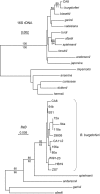Population structure of the lyme borreliosis spirochete Borrelia burgdorferi in the western black-legged tick (Ixodes pacificus) in Northern California
- PMID: 19783741
- PMCID: PMC2786521
- DOI: 10.1128/AEM.01704-09
Population structure of the lyme borreliosis spirochete Borrelia burgdorferi in the western black-legged tick (Ixodes pacificus) in Northern California
Erratum in
- Appl Environ Microbiol. 2010 Jan;76(1):386
Abstract
Factors potentially contributing to the lower incidence of Lyme borreliosis (LB) in the far-western than in the northeastern United States include tick host-seeking behavior resulting in fewer human tick encounters, lower densities of Borrelia burgdorferi-infected vector ticks in peridomestic environments, and genetic variation among B. burgdorferi spirochetes to which humans are exposed. We determined the population structure of B. burgdorferi in over 200 infected nymphs of the primary bridging vector to humans, Ixodes pacificus, collected in Mendocino County, CA. This was accomplished by sequence typing the spirochete lipoprotein ospC and the 16S-23S rRNA intergenic spacer (IGS). Thirteen ospC alleles belonging to 12 genotypes were found in California, and the two most abundant, ospC genotypes H3 and E3, have not been detected in ticks in the Northeast. The most prevalent ospC and IGS biallelic profile in the population, found in about 22% of ticks, was a new B. burgdorferi strain defined by ospC genotype H3. Eight of the most common ospC genotypes in the northeastern United States, including genotypes I and K that are associated with disseminated human infections, were absent in Mendocino County nymphs. ospC H3 was associated with hardwood-dominated habitats where western gray squirrels, the reservoir host, are commonly infected with LB spirochetes. The differences in B. burgdorferi population structure in California ticks compared to the Northeast emphasize the need for a greater understanding of the genetic diversity of spirochetes infecting California LB patients.
Figures


References
-
- Alghaferi, M. Y., J. M. Anderson, J. Park, P. G. Auwaerter, J. N. Aucott, D. E. Norris, and J. S. Dumler. 2005. Borrelia burgdorferi ospC heterogeneity among human and murine isolates from a defined region of northern Maryland and southern Pennsylvania: lack of correlation with invasive and noninvasive genotypes. J. Clin. Microbiol. 43:1879-1884. - PMC - PubMed
-
- Attie, O., J. F. Bruno, Y. Xu, D. Qiu, B. J. Luft, and W. G. Qiu. 2007. Co-evolution of the outer surface protein C gene (ospC) and intraspecific lineages of Borrelia burgdorferi sensu stricto in the northeastern United States. Infect. Genet. Evol. 7:1-12. - PubMed
-
- Bacon, R. M., K. J. Kugeler, and P. S. Mead. 2008. Surveillance for Lyme disease—United States, 1992-2006. MMWR Surveill. Summ. 57:1-9. - PubMed
-
- Barbour, A. G., G. O. Maupin, G. J. Teltow, C. J. Carter, and J. Piesman. 1996. Identification of an uncultivable Borrelia species in the hard tick Amblyomma americanum: possible agent of a Lyme disease-like illness. J. Infect. Dis. 173:403-409. - PubMed
Publication types
MeSH terms
Substances
Associated data
- Actions
- Actions
- Actions
- Actions
- Actions
- Actions
- Actions
- Actions
- Actions
- Actions
- Actions
- Actions
- Actions
- Actions
- Actions
- Actions
- Actions
- Actions
- Actions
- Actions
- Actions
- Actions
- Actions
- Actions
- Actions
- Actions
- Actions
- Actions
- Actions
Grants and funding
LinkOut - more resources
Full Text Sources
Medical
Molecular Biology Databases

